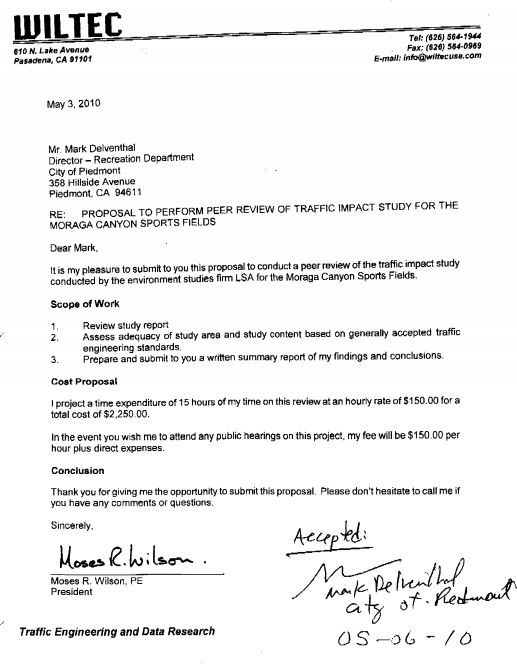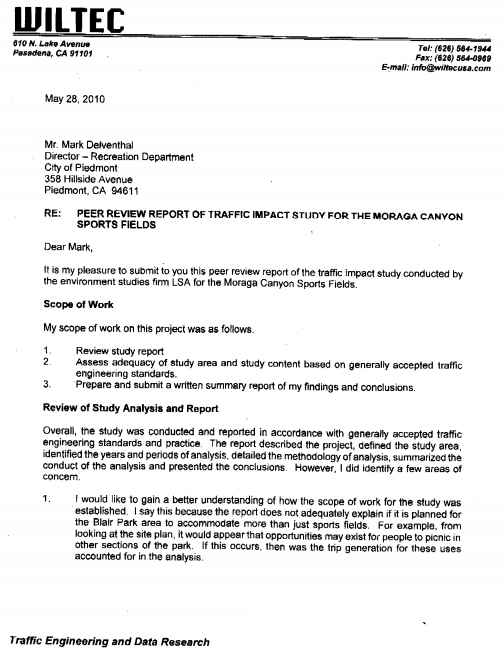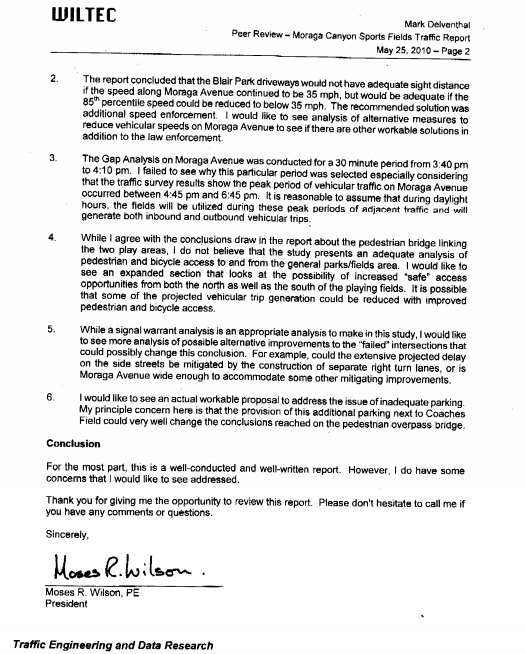Citizen Says City Withheld Traffic Advice on EIR
Citizen asks why 2010 EIR Traffic Review was not made public during Moraga Canyon/Blair Park EIR hearings –
During the discussion of a risk management policy for major Piedmont projects at the April 1, 2013 Council meeting, Piedmont resident Rick Schiller criticized City staff for “withholding” a City-authorized 2010 traffic study report of Moraga Ave. The report by WILTEC Engineers was procured by the City Administration at a critical point during the controversial Blair Park/Moraga Canyon sportsfield deliberation.
In 2012, 20 months after the City Council approved the Environmental Information Report (EIR) per the California Environmental Qualify Act (CEQA) for the proposal, Schiller discovered an unfamiliar line item in the City’s expenditures for the Blair Park/Moraga Canyon project. Through a public record request to the City, he received a Traffic Impact Study Review Report, which had been authorized by Recreation Director Mark Delventhal in 2010 and conducted by WILTEC. The $2,250 “peer review ” report examined the Moraga Avenue traffic study conducted by LSA and made some critical comments regarding LSA’s study.
At the April 1 Council meeting, Schiller made the following comments:
Risk assessment is all about protecting the public interest. The League addendum speaks of implementing a policy of open and transparent government. Item 1a is that risk assessment must include release of consultant reports. One of the fundamental contentious issues with the now rescinded Blair Park project
is whether the traffic analysis was adequate. Had the project gone forward, and there was a traffic accident or pedestrian injury resulting in litigation against the City, a plaintiff’s attorney unearthing previously withheld critical reports would likely find such documents advantageous.
The undisclosed WILTEC Traffic Peer Review was done by a consultant commonly used and respected by the City. The report reads like a list of opponent critiques including but not limited to inadequate parking and inadequate gap analysis. Regardless of a Pedestrian bridge or roundabouts, there are valid traffic concerns stated yet neither the public nor City Council were made aware of this Peer Review.
When residents have to dig out and obtain critical documents like the WILTEC Traffic Report and the City/PROF indemnification agreement by Public Records Request, government is far removed from transparency. A policy statement is needed that moves City hall towards open government as part of project risk assessment.
A final question. Why was the WILTEC report withheld from both Council and the public?
City Administrator Geoff Grote responded to Schiller, stating that the WILTEC report was a “peer review,” used “internally” and “it was not withheld from anybody.” Grote said the Administration wanted to understand the traffic questions by double checking. Further he stated, departments are encouraged to double check. He added that as a result of the report, changes were made in the proposed Blair Park design. Mayor Chiang mentioned the elimination of the bridge over Moraga Avenue and then closed off further discussion on Schiller’s question, “Why wasn’t the document disclosed?”
There is no information indicating that the City Council or the public received the traffic advice letter identifying many of the safety and traffic impact issues of concern or requiring further information in the traffic impact study by LSA for the EIR. The WILTEC traffic advice letter was not found in the EIR record.
At the Council meeting, Weiler and Chiang repeatedly made it clear they did not want to revisit the Moraga Canyon/Blair Park controversy.
CEQA requirements –
The California Environmental Quality Act (CEQA) requires “full public disclosure of the environmental impacts of a proposed project” as described below:
- “Environmental impact reports (EIRs) shall be used to provide full public disclosure of the environmental impacts of a proposed project.
- Local agencies should integrate CEQA with other environmental review, planning, and information gathering so as to cut costs and time and to apply the conservation of financial, governmental, physical, and social resources towards better mitigation.
- Identification of significant effects, alternatives and mitigation measures, as well as comments from the public and public agencies, and relevant information about significant effects should be made as early as possible in the process.
Failure to comply with CEQA to provide full disclosure of information during the CEQA process, which would result in relevant information not being presented to the public agency, would constitute prejudicial abuse of discretion leaving the project proponent open to possible lawsuits.”
Timeline on the trafic advice letter:
– May 3, 2010 – WILTEC proposal to Peer Review LSA traffic report for $2,250
– May 6, 2010 – Recreation Director accepts proposal by WILTEC
– May 28, 2010 – WILTEC produces Peer Review Advice Letter on traffic.
– Peer Review Traffic Advice Letter is not released to the public.
– Dec. 6, 2010 – Blair Park EIR is certified by the City Council following hearings.
– Jan. 13, 2011 – $2,250 is payed to WILTEC for work completed May 28.
– June 18, 2012 – City staff report on Moraga/ Blair expenditures shows the WILTEC payment.
– June, 2012 – WILTEC traffic advice letter is disclosed after public records request by resident.
– April 1, 2013 – WILTEC traffic advice letter is first openly discussed at City Council meeting.
Policies relating to Risk Management for City projects requested to be open and transparent to the public.
The Piedmont League of Women Voters recommended to the Council in their March 11, 2013 letter:
Open Government
The City’s management of major capital projects shall be conducted in a manner that is as open and transparent as possible with Piedmont citizens.
A. Public Disclosure of Studies and Other Contracted Reports. During the course of developing major capital projects, the City from time to time finds it necessary or desirable to retain consultants or experts to perform analyses of various aspects of projects. It should be the City’s policy to:
1) timely disclose to whom and for what purpose it has contracted for such a study; and 2) make public In a timely manner any outside analysis that is performed and reflected in a report.
This policy is intended to prevent the recurrence of incidents such as a traffic study for the Moraga Canyon project, which was apparently contracted for by the Recreation Department early in the City’s process of evaluating the project. Therefore was not disclosed to the public until after the project was approved and subsequently withdrawn. When the report’s author’s name appeared on a project cost summary prepared by the City, a Public Records Act request was filed for the report, which recommended traffic issues on Moraga Avenue be further addressed. Since these issues were contested between project proponents and opponents, timely publishing of the report would have served the public interest.
Questions relating to Risk Management –
Based on the newly discovered “internally” used information, the following questions have been raised:
– Is it lawful for staff to withhold information pertinent to EIR considerations from the public or Council?
– Who determines what is good for the public to know and what is not good?
Internal Letters –
Below are the internal letters between the Piedmont Recreation Director and Piedmont’s traffic engineer, Moses R. Wilson, PE of WILTEC dated May 3, 2010 and May 28, 2010.





